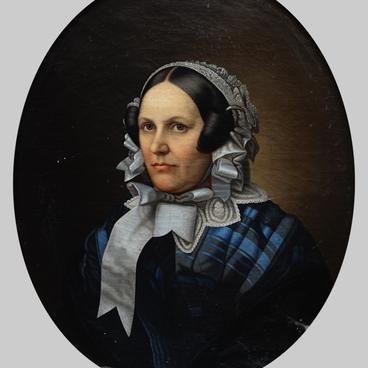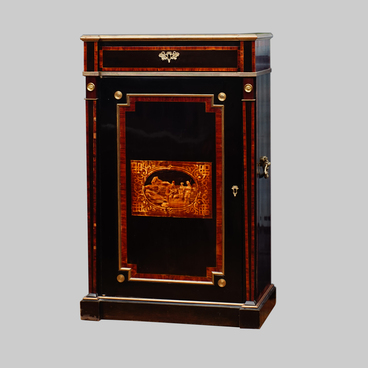Mechanical mantle clock in a decorative case. The clock could plausibly be dated to the early 19th century: the inscription ‘Avril 1828’ (April, 1828) was found on an old mainspring. If we assume that this is an original part, we could accurately determine the exact age of the clock based on that date.
On the outside of the plate, another inscription was found—"Bechot.’ This may be the name of the bronzer. In this context, “plate” is an interesting usage. In clock terminology, this word usually refers to the largest part of the frame of the clockwork mechanism. Platinum is used to fasten bridges and bearings of watch gears, often defining the shape of the whole mechanism.
The artistic solution of the watch case refers to the Ancient Greek myth of Orpheus and Eurydice. Their love story is one of the most poetic and dramatic myths.
Apollo gave his son Orpheus a lyre and taught him to play it. Orpheus mastered the instrument bestowed onto him, and so great was his talent that the teacher himself was amazed at his skill.
Orpheus fell in love with the forest nymph Eurydice and then married her, however, Hymenaeus (the deity of marriage), whom they invited to bless the marriage, predicted that their happiness would not last long. And indeed it did not. Shortly thereafter, Eurydice was bit by a snake whilst walking with the nymphs through the forest and died.
Orpheus expressed his grief in music. His songs touched everything and everyone in the world of the living. Then he decided to descend into the realm of the dead and get to Hades himself. The god of the underworld allowed Orpheus to take Eurydice, but on one condition. She must follow her husband, staying behind him, and Orpheus must not turn around, or he will never see her again.
Orpheus accepted that condition. However, when Orpheus was approaching the exit from the underworld, he did not hear the steps of Eurydice behind him. He thought that Hades had deceived him. Unable to bear it, he turned around, only to see the shadow of a nymph returning back to the kingdom of the dead.
Orpheus tried to return to the underworld, but a person cannot enter the kingdom of Hades twice during their lifetime. And so he lost Eurydice forever.
After Orpheus himself died, the muses decided to preserve the memory of him among living people so that the musical thread would not be interrupted.
The name of Orpheus is associated with the emergence of the cult rites of the Orphic mysteries and the religious and philosophical doctrine - Orphism. Some believe that Orphism became the prototype of later monotheistic religions, in particular, Christianity, since it marked the transition from polytheism to worship of the One God.
On the outside of the plate, another inscription was found—"Bechot.’ This may be the name of the bronzer. In this context, “plate” is an interesting usage. In clock terminology, this word usually refers to the largest part of the frame of the clockwork mechanism. Platinum is used to fasten bridges and bearings of watch gears, often defining the shape of the whole mechanism.
The artistic solution of the watch case refers to the Ancient Greek myth of Orpheus and Eurydice. Their love story is one of the most poetic and dramatic myths.
Apollo gave his son Orpheus a lyre and taught him to play it. Orpheus mastered the instrument bestowed onto him, and so great was his talent that the teacher himself was amazed at his skill.
Orpheus fell in love with the forest nymph Eurydice and then married her, however, Hymenaeus (the deity of marriage), whom they invited to bless the marriage, predicted that their happiness would not last long. And indeed it did not. Shortly thereafter, Eurydice was bit by a snake whilst walking with the nymphs through the forest and died.
Orpheus expressed his grief in music. His songs touched everything and everyone in the world of the living. Then he decided to descend into the realm of the dead and get to Hades himself. The god of the underworld allowed Orpheus to take Eurydice, but on one condition. She must follow her husband, staying behind him, and Orpheus must not turn around, or he will never see her again.
Orpheus accepted that condition. However, when Orpheus was approaching the exit from the underworld, he did not hear the steps of Eurydice behind him. He thought that Hades had deceived him. Unable to bear it, he turned around, only to see the shadow of a nymph returning back to the kingdom of the dead.
Orpheus tried to return to the underworld, but a person cannot enter the kingdom of Hades twice during their lifetime. And so he lost Eurydice forever.
After Orpheus himself died, the muses decided to preserve the memory of him among living people so that the musical thread would not be interrupted.
The name of Orpheus is associated with the emergence of the cult rites of the Orphic mysteries and the religious and philosophical doctrine - Orphism. Some believe that Orphism became the prototype of later monotheistic religions, in particular, Christianity, since it marked the transition from polytheism to worship of the One God.

